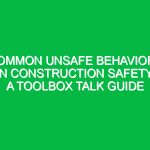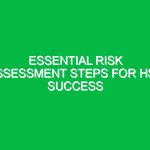Introduction
In the realms of Health, Safety, and Environment (HSE), the concept of risk assessment risk rating serves as a foundational pillar for ensuring Workplace Safety and environmental Sustainability. Risk assessment risk rating is a systematic process that evaluates potential Hazards, assesses the likelihood of their occurrence, and determines the severity of their impact on health and Safety. This structured approach not only helps organizations comply with Regulations but also fosters a culture of Safety that Benefits employees, stakeholders, and the environment alike.
Understanding the nuances of risk assessment risk rating is imperative. It provides the necessary framework for identifying risks, prioritizing Safety Measures, and implementing effective controls. In an era where workplace incidents can lead to severe consequences, both financially and socially, mastering these ratings can unlock the door to safety success.
Key Aspects of Risk Assessment Risk Rating in HSE
Understanding Risk Assessment
At its core, risk assessment is the process of identifying Hazards that could potentially cause harm, evaluating the risks associated with those hazards, and deciding on appropriate measures to mitigate them. The process typically involves several steps:
- Hazard Identification: Recognizing potential sources of harm, such as chemical spills, machinery malfunctions, or environmental impacts.
- Risk Analysis: Evaluating the likelihood of the identified hazards leading to incidents and the potential severity of those incidents.
- Risk Evaluation: Comparing estimated risks against risk criteria to determine their significance and prioritize responses.
- Risk Control: Developing strategies to minimize risks, including engineering controls, administrative policies, or Personal Protective Equipment (PPE).
Each of these steps is critical in crafting an effective risk assessment risk rating that not only identifies potential issues but also provides a roadmap for addressing them.
Components of Risk Assessment Risk Rating
The risk rating itself is typically represented in a matrix format, where the likelihood of occurrence is plotted against the severity of consequences. This risk matrix serves as a visual tool that aids in decision-making.
- Likelihood: This refers to the probability of a hazard occurring, often categorized as rare, unlikely, possible, likely, or almost certain.
- Severity: This indicates the potential impact of the hazard, categorized as insignificant, minor, moderate, major, or catastrophic.
By combining these two dimensions, organizations can categorize risks into various levels, such as low, medium, high, or critical, which helps in prioritizing efforts to mitigate them.
Benefits of Risk Assessment Risk Rating
Utilizing risk assessment risk ratings comes with numerous benefits. These include:
- Enhanced Safety: By identifying and mitigating risks, organizations can prevent accidents and injuries, fostering a safer workplace environment.
- Regulatory Compliance: Proper risk assessments help organizations comply with health and safety regulations, avoiding legal penalties and fines.
- Improved Decision-Making: The structured approach provided by risk ratings allows for informed decision-making regarding resource allocation and safety investments.
- Increased Productivity: A safe work environment leads to higher employee morale and productivity, as workers feel secure and valued.
- Environmental Protection: Effective risk assessments can also prevent environmental harm, ensuring sustainable practices that benefit the community and ecosystem.
Best Practices for Conducting Risk Assessments
To ensure effective risk assessment risk ratings, organizations should adopt several Best Practices:
1. Involve Employees
Engaging employees at all levels can provide valuable insights into potential hazards and how they can manifest in daily operations. Employees often have firsthand experience with risks that management may overlook.
2. Regularly Review and Update Assessments
Risk ratings should not be static. Regular reviews are essential as operations, equipment, and environmental conditions change over time. Scheduled assessments help ensure that risk ratings remain relevant and effective.
3. Use Technology Wisely
Leveraging technology, such as risk management software or data analytics tools, can streamline the risk assessment process, making it more efficient and comprehensive.
4. Train Staff Effectively
Continuous Training on risk assessment Procedures and the importance of safety can empower employees to recognize and report hazards proactively.
Real-Life Example: A Case Study
To illustrate the impact of effective risk assessment risk ratings, consider the case of a manufacturing plant that faced frequent equipment-related incidents. The management implemented a structured risk assessment process, starting with a thorough analysis of all machinery.
Through the risk assessment risk rating matrix, they identified specific machines with a high likelihood of causing accidents due to inadequate Safety Measures. By prioritizing these risks, they implemented upgraded safety features and conducted staff training on proper equipment handling.
As a result, the plant saw a significant reduction in incidents, enhancing workplace morale and productivity. This case underscores the importance of a proactive approach to risk assessment in achieving safety success.
Regulations and Standards Governing Risk Assessment Risk Rating
Risk assessment risk ratings are not just good practices; they are often mandated by various regulations and standards.
1. Occupational Safety and Health Administration (OSHA)
In the United States, osha requires that employers provide a workplace that is free from recognized hazards. Effective risk assessments are crucial for compliance with OSHA standards.
2. ISO 45001
This international standard outlines requirements for an Occupational Health and safety (OH&S) management system. It emphasizes the importance of risk assessment and management in ensuring employee safety.
3. Environmental Protection Agency (EPA)
In the context of Environmental Safety, the EPA mandates risk assessments for activities that may impact the environment, ensuring that organizations consider potential environmental hazards in their operations.
Conclusion
In summary, risk assessment risk rating is an essential component of the Health, Safety, and Environment domain. It provides a structured approach to identifying and mitigating hazards, thereby enhancing Workplace Safety and environmental sustainability. By understanding and applying the principles of risk assessment risk ratings, organizations can not only comply with regulations but also foster a culture of safety that benefits everyone involved.
Implementing effective risk assessment practices is not merely a regulatory obligation; it is a commitment to ensuring the well-being of employees and the environment. As we move forward in an ever-evolving landscape, the emphasis on robust risk assessment frameworks will be crucial in unlocking safety success. Organizations must prioritize these assessments and make them a central element of their operational strategy to achieve lasting safety and environmental outcomes.


